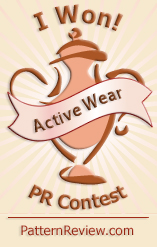Here's a clue: it wasn't summer there.
OK, here's another clue:

I was in Australia! As a Canadian I can tell you this: their winter is for sissies. You can go to the beach and swim in the ocean in the middle of winter, for heaven's sake. You can wear shorts outside. The sun shone almost every day, and it was not even a bit humid. It was glorious! For my money, July is definitely the time of year to go to Australia.
Work took me there; I was lucky enough to get approval to attend two excellent legal conferences being held at the University of Melbourne so I was there for two weeks. After that, a holiday ensued. My husband and I headed north to Cairns and then to Sydney before flying home. We ate, we drank, we walked (a lot!), we swam in the ocean (well, we snorkeled), we went to rainforests, on beautiful coastal roads, to mountains, on a wine tour, we saw wildlife, many colourful fish and birds, fabulous tropical flowers and much gigantic foliage. It was a lot of fun!
 My being a tourist has nothing really to do with sewing, but I did find time to do a bit of fabric shopping in Sydney. I bought wool jersey and gorgeous guipure lace at The Fabric Store (good timing on the Sale!) and some Liberty at Tessuti. My good intention is to sew it all up in the medium term.
My being a tourist has nothing really to do with sewing, but I did find time to do a bit of fabric shopping in Sydney. I bought wool jersey and gorgeous guipure lace at The Fabric Store (good timing on the Sale!) and some Liberty at Tessuti. My good intention is to sew it all up in the medium term. But my first project from my fabric purchases down under is this shirt made from humble quilting cotton that I bought in downtown Sydney. I went looking for yardage in prints by aboriginal artists after seeing tourist items made out of this type of fabric, and seeing aboriginal art in museums.
But my first project from my fabric purchases down under is this shirt made from humble quilting cotton that I bought in downtown Sydney. I went looking for yardage in prints by aboriginal artists after seeing tourist items made out of this type of fabric, and seeing aboriginal art in museums.This print is a design called Water Dreaming by Audrey Martin Napanangka for M&S Textiles, Australia. I just googled it and find that it is available for sale by that name on the internet (for example here, in a different colourway). According to the M&S website, "The long curved lines indicate the movement of water in the area. Dotted lines and smaller circles indicate various soakages, broken roads, sands, etc." There are a lot of different aboriginal prints available and most of them relate to features of indigenous life on the land - water, food, animals and plants.
So the shirt. This is one of the newest Jalie patterns, "Rose" (3881). It's a straightforward sleeveless shirt with a lined yoke, stand collar, back pleat and subtle shirt-tail hem. I participated in the testing of this batch of patterns (14 new ones were released in the spring) and this is one of the patterns I sewed up before it was fine tuned and released for sale.
 The testing was an interesting process. Our job was to make up the patterns according to the instructions, and to provide detailed comments back to Jeanne, Émilie and Mel so they could tweak the designs, fix typos, improve the instructions, and generally get everything exactly right. When I tested the pattern I used a relatively tightly woven cotton from stash - results at right (this style works well in bold ethnic prints!). You cannot tell from these photos but the finished pattern is quite refined compared to the version I tested, especially in terms of the collar shape and dimensions. Jalie is nothing if not attention to details!
The testing was an interesting process. Our job was to make up the patterns according to the instructions, and to provide detailed comments back to Jeanne, Émilie and Mel so they could tweak the designs, fix typos, improve the instructions, and generally get everything exactly right. When I tested the pattern I used a relatively tightly woven cotton from stash - results at right (this style works well in bold ethnic prints!). You cannot tell from these photos but the finished pattern is quite refined compared to the version I tested, especially in terms of the collar shape and dimensions. Jalie is nothing if not attention to details! I was particularly skeptical of the instructions for making the stand collar. I've seen different methods illustrated in various patterns over the years and for a long time the results I got when making these collars was a long way less than stellar. In particular I would get lumpy bumps right at the key point where the stand meets the shirt front, right below your chin, right where it will be noticed and scream "loving hands at home".
 Being a perfectionist, I had worked hard to overcome the problem and recently, I had been using a method David Page Coffin wrote about in his book on shirt making. This gave pretty good results but his method is a little ... complicated ... and a bit counter-intuitive. Nevertheless I was reluctant to abandon it and so I chickened out when I tested the pattern. I did not use the method that the Jalie instructions suggested. Which, I now realize, was a missed opportunity.
Being a perfectionist, I had worked hard to overcome the problem and recently, I had been using a method David Page Coffin wrote about in his book on shirt making. This gave pretty good results but his method is a little ... complicated ... and a bit counter-intuitive. Nevertheless I was reluctant to abandon it and so I chickened out when I tested the pattern. I did not use the method that the Jalie instructions suggested. Which, I now realize, was a missed opportunity. |
| LOOK, no bump! |
I had enough fabric to make a completely self-fabric collar and stand and had thought to make a completely contrasting white one but when someone whose style you respect tells you that it might be a tiny bit too Wall Street, you reconsider. In the end, the contrast is there but also sort of undercover. I kind of like it.
Anyway, the bottom line is not only is this a refined little shirt that is very easy to wear, it is worth buying it for the collar instructions. What are you waiting for?



Great post! I made the shirt, too, and love the collar!
ReplyDeleteHa ha you are so right that our winters are barely winter at all, yet it doesn’t stop us complaining about how cold it is! I can’t say I’ve seen a great deal of Aboriginal print fabrics, but yours looks lovely made up
ReplyDeleteThe lovely young woman who cut my fabric at The Fabric Store had on a top she had made from one of the prints. You should look for them.
DeleteI couldn't figure why I couldn't choose either the white collar or the self fabric collar, but I really like this option !
ReplyDeleteWhat a great new shirt and a wonderful vacation!
ReplyDeleteAh yes our winters are beautiful. I'm glad you had a great time and got a lovely fabric souvenir.
ReplyDeleteNice shirt! I’m so glad to hear about these stand instructions.
ReplyDeleteI love the Aboriginal print fabrics. I hope to find a source in North America. They are beautiful.
ReplyDelete